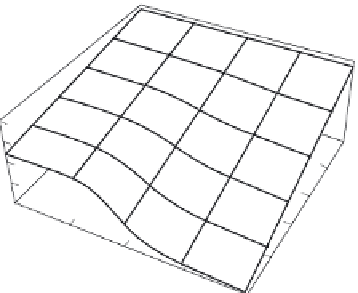Environmental Engineering Reference
In-Depth Information
Fig. 5.14
The relative
density of skylarks in
fi elds in winter (vertical
axis; unity indicates
fi eld use before the
introduction of GM
crops) in relation to ρ
(horizontal axis;
positive values mean
farmers are more likely
to adopt GM technology
where seed densities are
currently high, negative
values where seed
densities are currently
low) and to the
approximate reduction
in weed seed bank
density due to the
introduction of GM
crops (Γ, third axis;
realistic values are
those less than 0.1).
(After Watkinson et al.,
2000.)
1.0
0.8
0.6
0.4
0
1.0
0.8
0.6
0.4
Γ
-1
0
0.2
log
ρ
1
0
means that the impact of GM sugar beet will depend critically on the extent to which
high-density patches of weeds are affected.
The steps in building their model of GM sugar beet/fat hen/skylark populations
are as follows. First, they built a general model of the population dynamics of fat
hen in a sugar beet crop. Next they modifi ed this to simulate the effect of the intro-
duction of GM sugar beet on the weed population (densities of fat hen are expected
to be reduced by about 90%). Then they incorporated the predicted use of fi elds by
skylarks according to weed seed density (as shown in Figure 5.13a).
Farmer behavior was also modeled. Before the introduction of GM technology
most farms had a relatively low density of weed seeds, but a few had very high
densities (solid line in Figure 5.13b). The probability of a farmer adopting GM crops
is related in the model to seed bank density through a parameter
ρ
. Positive values
of
mean that farmers are more likely to adopt the technology where seed densities
are currently high and there is the potential to reduce yield losses to weeds. This
leads to an increase in the relative abundance of low-density fi elds (dotted line in
Figure 5.13b). Negative values of
ρ
indicate that farmers are more likely to adopt
the technology where seed densities are currently low (intensively managed farms),
perhaps because a history of effective weed control is correlated with a willingness
to adopt new technology. This leads to a decreased frequency of low-density fi elds
(d a shed line in Figure 5.13b). The way that farmers will respond is not self-evident
and Watkinson's team argued that this needs to be included in the model.
It turns out that the relationship between current weed levels and uptake of the
new technology (
ρ
) is as important to bird populations as the direct impact of the
technology on weed abundance (
ρ
Γ
), because small positive or negative changes to
ρ
give quite different skylark densities (Figure 5.14). In other words, predicting the
impact of GM technology on biodiversity requires not only an understanding of
how the ecological system operates but also of how the farming community will
respond.
5.6.2
Diclofenac -
good for sick cattle,
bad for vultures
In early 1997 white-backed vultures began dropping from their perches to die
shortly afterwards. Local people in India and other parts of South Asia were
quick to notice dramatic declines in vulture numbers, but the reasons perplexed
scientists. A conference called in Mumbai, India, in August 1999 to consider the
possible causes was eerily reminiscent of a similar meeting held 34 years earlier in


























Search WWH ::

Custom Search